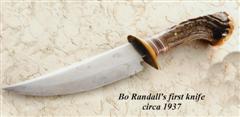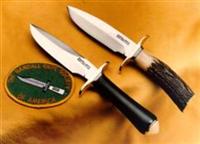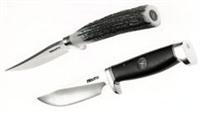The contrary assumption that Johnson made those Randall-stamped, Heiser look-alike sheaths, long before he was known to be making sheaths, is the fanciful argument. Oddly, there was never a formal case made for that amazing assumption, never in time, ever. But if you would like to make such a case, publish analogs, offer proof, or even a decent, logical argument that Johnson made all those sheaths in 1959-60-61, I'll be glad to consider it.
The burden of proof is on that argument, not the one favored by the overwhelming evidence that has already been presented.
My question to you ... If you have not read the case that has been carefully put together, meticulously documented, and can't address it's fundamental points, why are you negatively involved here? I don't recall you offering examples or pitching in with help when the case was first being critically examined (but perhaps you did, in which case I apologize for my error). But many other collectors were involved. They did pitch in, as questions, offer examples, checked out timing, etc., using knives from their private collections, etc. So... perhaps you will understand when I ask..what is your point here?
This is my point:
I think your first mistake (of several) Jack is the "
Heiser look-alike" misnomer. I don't think from the beginning of these threads that is what I was saying, that the sheaths were "
look-a-likes". In fact, I was saying the exact opposite and it was made
very clear.
It is apparent that there are distinct differences from those "
Heiser look-alike" sheaths and the sheaths that would be Johnsons, the sheaths you have in my opinion grossly misidentified. In this case, I do not believe there is a ď
Heiser look-alikeĒ as you describe it. It is either a Heiser/HKL or a Johnson. Thatís it. There is no Johnson sheath that is an exact copy of a Heiser/HKL. My photo of the four #1 sheaths side by side is very telling showing the progression of the sheaths. The photo of the three #1 sheaths Jimmy posted superbly reinforces the differences between the makers. Come to think of it, so does the photo of the 5 #1ís by Gary Clinton, and the #3 ensemble Ron posted. Say it ainít so!
Now I want you to pay close attention, this conversation was about
who made a particular sheath, not when, as that has been settled. While the time and maker are intertwined, for this disscusion we are looking at the characteristics of the sheaths only. At this juncture, I am sure you have not examined enough of these sheaths in hand to actually formulate a reasonably accurate assessment. From your posts, I gleaned that most if not all of your "research" was comprised of reviewing photographs sent to you by a collector(s). While photos only are not the ideal method, and I think in many cases you can still formulate an opinion with some degree of accuracy, you have to have some idea what you are looking at to begin with.
So Jack (and we must include Ron), since we are using photos and some of the characteristics differences are readily visible even to the novice, you can now offer up your opinion(s). You have had the opportunity to examine the photos I have posted as well as photos by others who have graciously lent some items from their collections.
Bottom line is your theory, thesis, or whatever you want to call it about center keeper snap location and "west" facing logo stamp being a Heiser/HKL exclusive is fatally flawed. What say you?
The readers here would like to hear what you (and Ron) have to say now that your request for "
proof and a decent, logical argument" has been presented in such a marvelous and cogent fashion.















